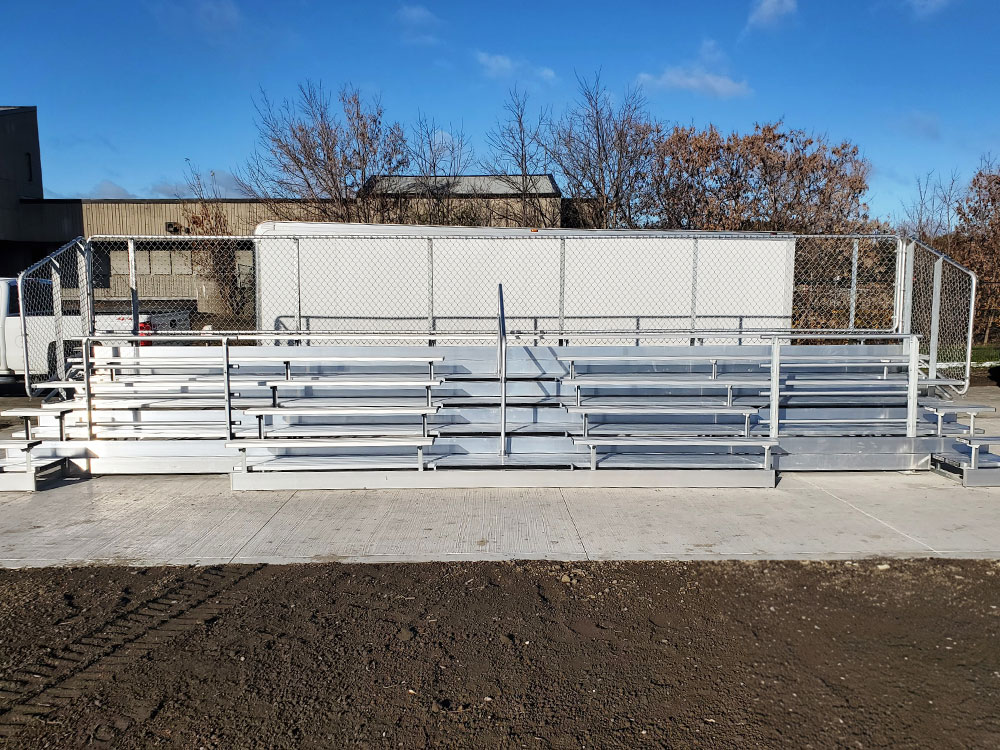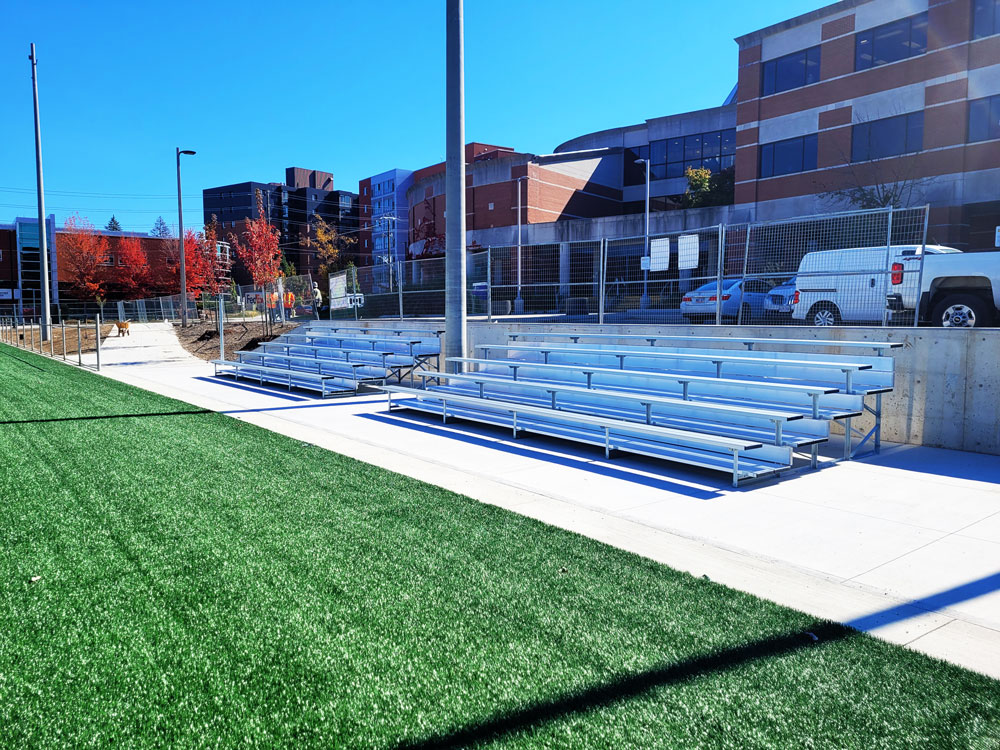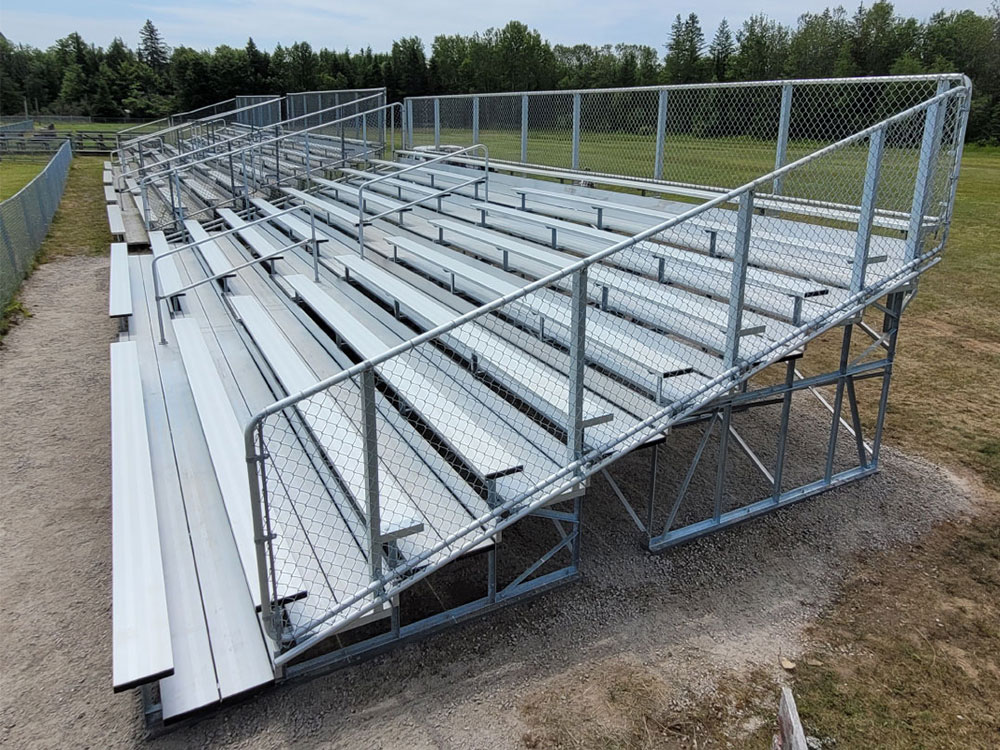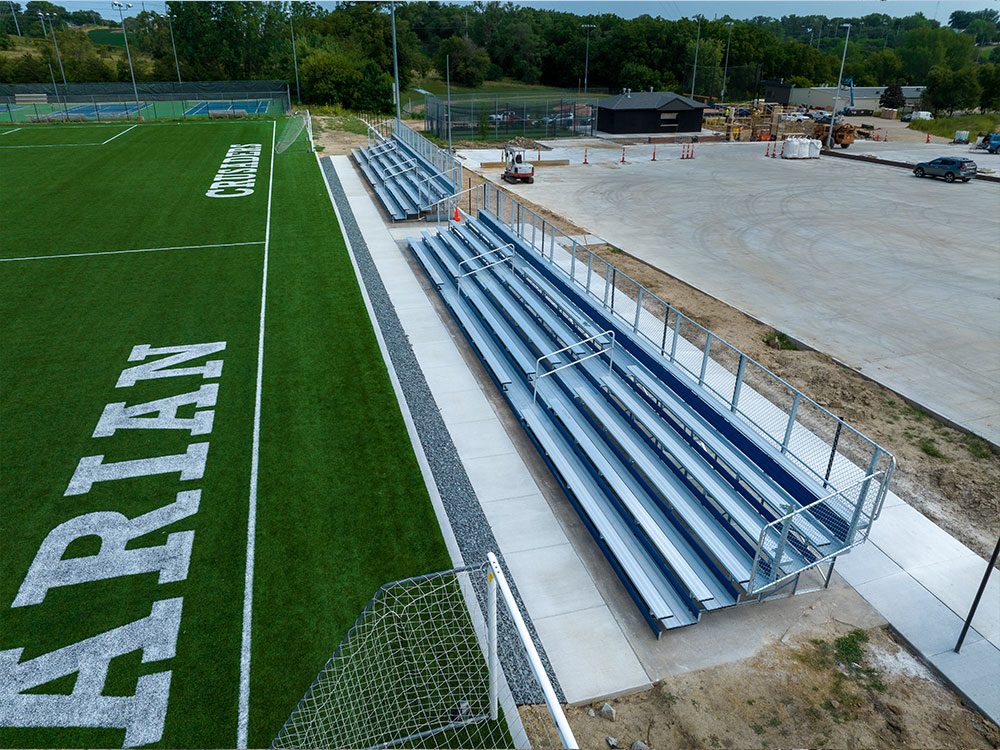How Bleachers 101 works
For the past 40 years, we at Sport Systems have dedicated ourselves to designing, manufacturing and installing industry leading athletic infrastructure and equipment. Over time, we have fielded thousands of questions from our wonderful clientele and found that time and time again, many of the questions people have when purchasing bleachers remain the same.
We found that in order to find the right bleacher system, we typically have to answer the same core group of questions.
You’ll find them below along with the answers.
Frequently Asked Questions
You’ve got questions, we’ve got answers. Here’s a quick selection of some of the most common questions we field on a daily basis.
What is the difference in “Elevated Bleachers” and “Non-Elevated Bleachers”?
Typically speaking, elevated bleachers are usually larger in size and are used when spectator visibility is a main concern. These elevated units offer a clear line of sight by eliminating visual distractions, such as passers-by, walls, barricades or other ground-level obstructions. Read more about the differences…
What are Tip & Roll Bleachers?
Tip and roll bleacher systems are your go-to choice when looking for a quick and versatile seating solution when only temporary seating is required. These bleacher systems are easily tipped up onto their swivel casters for easy movement and are equipped with caster brakes to keep the bleacher from rolling while in storage. View our tip and roll bleachers.
What is Rise Height & Tread Depth?
Rise height refers to the vertical measurement from the top of one bleacher seat to the top of the bleacher seat in the next row. Tread Depth refers to the depth or horizontal measurement of the front of a bleacher seat to the front of the bleacher seat in the next row.
What is a Riser Board or a Plank?
This term refers to a piece of aluminum that is attached underneath the seats and behind spectators feet, which closes the open area between the seating plank and foot plank. Riser boards come in standard aluminum “mill finish” or can be coloured.
Are guard rails required on my bleachers?
Canada – If the unit you are purchasing has a seat height anywhere in the unit of 48” or greater, typically guard railing is required for that unit at those points.
USA – If the unit you are purchasing has a seat height anywhere in the unit of 30” or greater, typically guard railing is required for that unit at those points.
What is the difference between Grandstands and Stadium Bleachers?
Grandstands are the larger, more complex seating system when comparing the two… Read more about the differences
What are some safety precautions I should take into consideration for new or existing bleachers?
Checking any exterior hardware, welds, handrails, anchors and lubrication points is a great start. Read our article 6 STEPS TO ENSURE BLEACHER SAFETY for more information.
Can Sport Systems assemble my bleachers for me and deliver them to me?
Yes! We have developed a service program allowing our end users to receive their bleachers in a ready-to-use state, without any time investment and the hassle that can sometimes accompany in-house assembly…Click to read more
Can I make my existing bleachers portable or mobile?
In the event your facility did not initially purchase a mobile bleacher system, we do have a unique solution to quickly retrofit your existing bleachers into a safe and Easy-to-move transportable seating system. Effectively converting your existing bleacher seating into a mobile seating solution involves two bleacher tow kits; a bracing kit and a wheel and tongue kit. Here’s how they work…Click to read more
What can I do to make my bleachers more accessible for those with disabilities?
Over the past decade, there have been some much needed changes and updates applied to major legislation here in North America regarding accessibility for people with disabilities. These changes have paved the way for facilities to create environments that go well beyond simply retrofitting a physical location with wheelchair access. These changes take into account those living with disabilities by allowing all participants and spectators equal access to our sports equipment and infrastructure, providing a safe and inclusive environment for all…Click to read more
Are my bleachers at risk to theft?
Over the past decade, we have seen a dramatic increase in both demand and therefore, price paid for raw metals. A direct result of this is a paired increase in the number of thieves targeting athletic facilities, high schools, universities, colleges and public park properties for their rows upon rows of aluminum. Bleachers are not the only targets of these fly-by-night thieves, there have also been various thefts of Players benches, aluminum tables and a number of other metal-based outdoor products…Read our article about how you can prevent bleacher theft
What size of bleachers do I need?
As a general rule of thumb, we recommend about 18” of space for an individual seat. Meaning for every 18” of space per seating platform, you should attribute one seat. For illustration purposes we will use our BL-4TB-12DR 4-row aluminum bleachers, measuring at 144″ x 82″ x 38″ for a total of 576” of total seating space. Divide that number by our standard 18” per person measurement and you are looking at seating for about 32 people. This is an easy calculation to help you assess your seating needs…Click to read more
What is the typical width of a seat?
Excluding chair back seats, standard aluminum seat width is 18″. This number can, however, vary depending on a client’s specific needs.
Can I install my own small bleachers?
Yes – many of our smaller bleacher product lines are easily assembled at the job site with your own employees and workers. We always provide simple installation guidelines from which to work.
What’s the difference between gross and net seating capacity?
To find the gross seating capacity of a bleacher, take the length of the unit divided by 18” and then multiply by the number of rows in the unit. Net seating is the gross seating, minus the seating lost due to aisles and handicap space requirements. Net seating is directly affected by building code compliance.
What options are available for guard rail of stands reaching more than 30"(USA) or 48” (Canada) in height?
Bleachers come standard with galvanized chain link fence but can be ordered with optional black vinyl chain link fence or vertical picket rail.
What materials do you use in your bleachers and grandstands?
On our angle frame product we use either aluminum angle or galvanized steel angle. On our grandstand product the structure is galvanized steel. All decking and seats are extruded aluminum, although there is the option for plastic chair seating.
Under what circumstances is it preferable to choose aluminum frame over galvanized frames for bleachers?
With wooden bleachers becoming a thing of the past, more sports fields and facilities are turning to either aluminum or galvanized steel bleacher systems…Click to read more
Do You Have A Glossary Of Terms Related To Bleachers?
Of course, read our Bleachers glossary.
request a quote
Bleacher Video gallery
Playlist
Sample Bleacher Gallery

Accessible bleacher with custom wheelchair cutouts and railings.

Two 5-row bleachers along sideline of football field.

10-row bleachers used at fair grounds for an agricultural society.

Two banks of custom 6-row bleachers along football field sideline.
building better bleachers
If you can dream it, we can build it.








